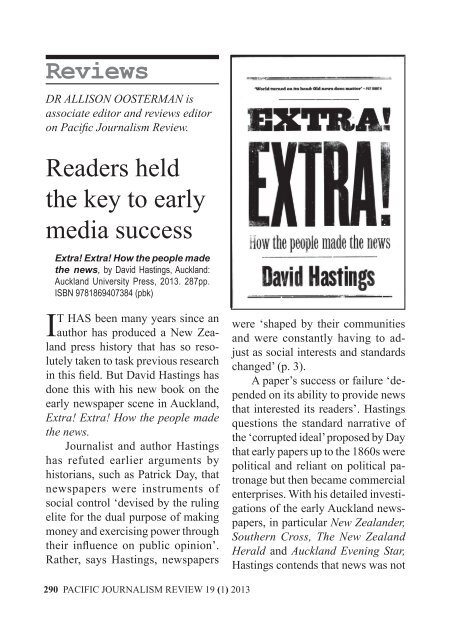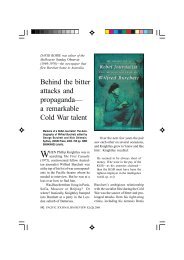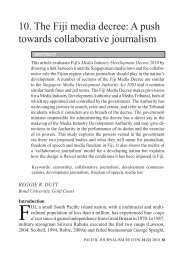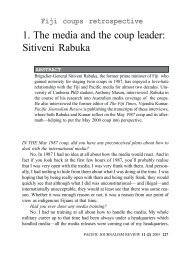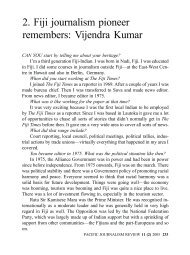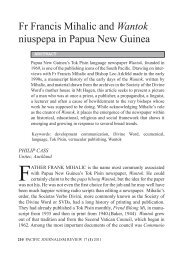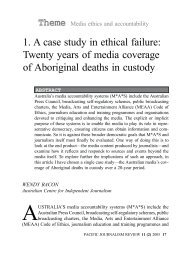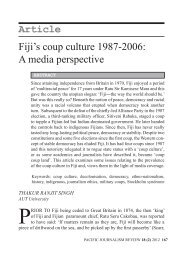Reviews Readers held the key to early media success - Pacific ...
Reviews Readers held the key to early media success - Pacific ...
Reviews Readers held the key to early media success - Pacific ...
You also want an ePaper? Increase the reach of your titles
YUMPU automatically turns print PDFs into web optimized ePapers that Google loves.
MEDIA AND DEMOCRACY IN THE PACIFIC<br />
<strong>Reviews</strong><br />
DR ALLISON OOSTERMAN is<br />
associate edi<strong>to</strong>r and reviews edi<strong>to</strong>r<br />
on <strong>Pacific</strong> Journalism Review.<br />
<strong>Readers</strong> <strong>held</strong><br />
<strong>the</strong> <strong>key</strong> <strong>to</strong> <strong>early</strong><br />
<strong>media</strong> <strong>success</strong><br />
Extra! Extra! How <strong>the</strong> people made<br />
<strong>the</strong> news, by David Hastings, Auckland:<br />
Auckland University Press, 2013. 287pp.<br />
ISBN 9781869407384 (pbk)<br />
IT HAS been many years since an<br />
author has produced a New Zealand<br />
press his<strong>to</strong>ry that has so resolutely<br />
taken <strong>to</strong> task previous research<br />
in this field. But David Hastings has<br />
done this with his new book on <strong>the</strong><br />
<strong>early</strong> newspaper scene in Auckland,<br />
Extra! Extra! How <strong>the</strong> people made<br />
<strong>the</strong> news.<br />
Journalist and author Hastings<br />
has refuted earlier arguments by<br />
his<strong>to</strong>rians, such as Patrick Day, that<br />
newspapers were instruments of<br />
social control ‘devised by <strong>the</strong> ruling<br />
elite for <strong>the</strong> dual purpose of making<br />
money and exercising power through<br />
<strong>the</strong>ir influence on public opinion’.<br />
Ra<strong>the</strong>r, says Hastings, newspapers<br />
were ‘shaped by <strong>the</strong>ir communities<br />
and were constantly having <strong>to</strong> adjust<br />
as social interests and standards<br />
changed’ (p. 3).<br />
A paper’s <strong>success</strong> or failure ‘depended<br />
on its ability <strong>to</strong> provide news<br />
that interested its readers’. Hastings<br />
questions <strong>the</strong> standard narrative of<br />
<strong>the</strong> ‘corrupted ideal’ proposed by Day<br />
that <strong>early</strong> papers up <strong>to</strong> <strong>the</strong> 1860s were<br />
political and reliant on political patronage<br />
but <strong>the</strong>n became commercial<br />
enterprises. With his detailed investigations<br />
of <strong>the</strong> <strong>early</strong> Auckland newspapers,<br />
in particular New Zealander,<br />
Sou<strong>the</strong>rn Cross, The New Zealand<br />
Herald and Auckland Evening Star,<br />
Hastings contends that news was not<br />
290 PACIFIC JOURNALISM REVIEW 19 (1) 2013
invented by commercialism but was<br />
<strong>the</strong> discovery that certain <strong>to</strong>pics had<br />
always been interesting <strong>to</strong> readers and<br />
had commercial value when ‘packaged,<br />
printed and sold’. He is talking<br />
about such <strong>to</strong>pics as crime, disasters<br />
and o<strong>the</strong>r extraordinary events (p. 6).<br />
Hastings has concentrated his<br />
research on <strong>the</strong> ‘newspaper wars’<br />
in Auckland in <strong>the</strong> 19th century and<br />
aims <strong>to</strong> ‘explain what forces and influences<br />
made <strong>the</strong> four papers what <strong>the</strong>y<br />
were’ (p. 8).<br />
‘The narrative that emerges calls<br />
in<strong>to</strong> question some of <strong>the</strong> standard<br />
assumptions, generalisations and halftruths<br />
that have been recycled through<br />
<strong>the</strong> admittedly limited his<strong>to</strong>riography<br />
on <strong>the</strong> subject,’ he says (p. 9). Dutch<br />
his<strong>to</strong>riographer Frank Ankersmit<br />
as long ago as 1997 lamented <strong>the</strong><br />
overproduction of his<strong>to</strong>ries on every<br />
conceivable subject such that it was<br />
almost impossible for a reader <strong>to</strong><br />
obtain a comprehensive view (Ankersmit,<br />
1997, p. 277).<br />
As Hastings notes, this is not <strong>the</strong><br />
case for New Zealand’s press his<strong>to</strong>ry<br />
where scholarship in <strong>the</strong> field is ra<strong>the</strong>r<br />
limited, although Redmer Yska’s<br />
Truth, in 2010, was a welcome addition.<br />
Considering <strong>the</strong> lack of interest<br />
shown by many of <strong>the</strong> country’s<br />
newspapers in conserving <strong>the</strong>ir valuable<br />
his<strong>to</strong>rical records and documents<br />
it is not surprising <strong>the</strong> field is under-<br />
MEDIA AND DEMOCRACY IN THE PACIFIC<br />
researched. It is notable that even as<br />
a Herald journalist Hastings has not<br />
used, or been able <strong>to</strong> use, any minute<br />
books, letter books, wage books, or<br />
o<strong>the</strong>r 19th century company records<br />
from his employer.<br />
Nobody seems <strong>to</strong> know where<br />
any of <strong>the</strong>se records are, whe<strong>the</strong>r<br />
it is for <strong>the</strong> Herald or for <strong>the</strong> Star.<br />
Repeated attempts by this writer <strong>to</strong><br />
discover what old records have been<br />
preserved have come <strong>to</strong> nought.<br />
Sadly this is a similar s<strong>to</strong>ry<br />
around <strong>the</strong> country, except for perhaps,<br />
Dunedin, where some of <strong>the</strong><br />
<strong>early</strong> Otago Daily Times records have<br />
been deposited in <strong>the</strong> Hocken Library.<br />
Hastings would not have been able<br />
<strong>to</strong> do such a good job on <strong>the</strong> <strong>early</strong><br />
Auckland newspaper scene if it hadn’t<br />
been for <strong>the</strong> personal manuscripts of<br />
some of <strong>the</strong> major figures such as<br />
Henry Brett, David Burn, Thomson<br />
Leys et al.<br />
Some of <strong>the</strong> ‘standard narratives’<br />
that Hastings has contested<br />
in his book include <strong>the</strong> idea that<br />
papers were started solely for political<br />
purposes, that <strong>the</strong>y had no interest<br />
in covering local news, that <strong>the</strong><br />
establishment of <strong>the</strong> national press<br />
agency, <strong>the</strong> UPA, lead <strong>to</strong> a uniformity<br />
of news coverage and that <strong>the</strong>re was<br />
no clash of ideas because newspapers<br />
served <strong>the</strong> interests of <strong>the</strong> ruling elite<br />
(p. 9). It was never that simple, says<br />
PACIFIC JOURNALISM REVIEW 19 (1) 2013 291
MEDIA AND DEMOCRACY IN THE PACIFIC<br />
Hastings. Newspapers fought <strong>the</strong>ir<br />
battles and <strong>the</strong> prize was profit and a<br />
say in politics, but readers were <strong>the</strong><br />
<strong>key</strong> <strong>to</strong> <strong>success</strong> or failure (p. 10).<br />
Having laid out his argument in<br />
<strong>the</strong> introduction, Hastings <strong>the</strong>n sets<br />
about proving it with his detailed and<br />
fascinating research in<strong>to</strong> <strong>the</strong> <strong>early</strong><br />
newspaper battles in Auckland starting<br />
with <strong>the</strong> birth of <strong>the</strong> New Zealander,<br />
which lasted for a little more than<br />
20 years, and locked in a fierce battle<br />
with <strong>the</strong> Sou<strong>the</strong>rn Cross, founded in<br />
1843. It was this battle between <strong>the</strong>se<br />
papers that Hastings claims revealed<br />
much about <strong>the</strong> ‘intense commercial<br />
and political pressures that all newspapers<br />
came under as well as <strong>the</strong> overriding<br />
importance of reader interests<br />
in deciding <strong>the</strong> vic<strong>to</strong>r’ (p. 14).<br />
He moves on <strong>to</strong> <strong>the</strong> impact of<br />
The New Zealand Herald and <strong>the</strong> rise<br />
of <strong>the</strong> Auckland Evening Star as its<br />
major competi<strong>to</strong>r.<br />
The his<strong>to</strong>ries of <strong>the</strong>se papers<br />
would be nothing without <strong>the</strong> men<br />
who ran or wrote for <strong>the</strong>m and Hastings<br />
paints a lively picture of <strong>the</strong> men<br />
of <strong>the</strong> <strong>early</strong> Auckland press. From<br />
John Williamson <strong>to</strong> Henry Brett,<br />
Hugh Carle<strong>to</strong>n <strong>to</strong> Thomson Leys,<br />
Joseph Wilson <strong>to</strong> William Berry, <strong>the</strong>se<br />
men fought <strong>the</strong> battle for readership,<br />
sometimes succeeding and in <strong>the</strong> case<br />
of <strong>the</strong> New Zealander and Sou<strong>the</strong>rn<br />
Cross, eventually failing. None of <strong>the</strong><br />
<strong>success</strong>ful edi<strong>to</strong>rs, claims Hastings,<br />
lost sight of <strong>the</strong> golden rule—that <strong>the</strong><br />
‘readers <strong>held</strong> <strong>the</strong> <strong>key</strong> <strong>to</strong> vic<strong>to</strong>ry in <strong>the</strong><br />
newspaper wars and what <strong>the</strong>y wanted<br />
most of all was news’ (p. 251).<br />
Extra! Extra! is an important<br />
book, and not before time. This is a<br />
scholarly, well researched and eminently<br />
readable book of interest <strong>to</strong> <strong>the</strong><br />
wider public as much as <strong>to</strong> academics<br />
studying in this field. It might be <strong>the</strong><br />
spur for o<strong>the</strong>rs <strong>to</strong> research and write<br />
about o<strong>the</strong>r notable New Zealand<br />
newspapers.<br />
However, unless <strong>the</strong> his<strong>to</strong>rical<br />
documents are available, such as diaries<br />
and personal papers that families<br />
have donated <strong>to</strong> research libraries, I<br />
fear <strong>the</strong> mysterious disappearance of<br />
press records will stymie any attempt.<br />
References<br />
Ankersmit, F. R. (1997). In Jenkins, K.<br />
(Ed.), The postmodern his<strong>to</strong>ry reader.<br />
London: Routledge, p. 277.<br />
Yska, R. (2010). Truth: The rise and fall<br />
of <strong>the</strong> people’s paper. Nelson: Craig<br />
Pot<strong>to</strong>n Publishing.<br />
292 PACIFIC JOURNALISM REVIEW 19 (1) 2013
Professor JUDY McGREGOR<br />
is head of <strong>the</strong> School of Social<br />
Sciences at AUT University and a<br />
former newspaper edi<strong>to</strong>r.<br />
MEDIA AND DEMOCRACY IN THE PACIFIC<br />
Meticulous<br />
study of<br />
<strong>early</strong> colonial<br />
infanticide<br />
Women, Infanticide and <strong>the</strong><br />
Press,1822-1922: News narratives<br />
in England and Australia, by Nicola Goc.<br />
Surrey, England: Ashgate Publishing, 2013.<br />
203pp, ISBN 9781409406044 (pbk)<br />
EVERY ONCE in a while an<br />
academic researcher will privately<br />
concede <strong>the</strong>y would like <strong>to</strong><br />
have written <strong>the</strong> book <strong>the</strong>y have<br />
reviewed. Count me in that category.<br />
Nicola Goc’s examination of<br />
news narratives of infanticide from<br />
1822-1922 in Britain and Australia<br />
reveals painstaking scholarship. It<br />
yields insights in<strong>to</strong> <strong>the</strong> primacy of<br />
crime news, <strong>the</strong> ideology of infanticide<br />
news discourse, <strong>the</strong> privileging<br />
of medical and legal voices in<br />
courtroom reportage, and <strong>the</strong> personification<br />
of infanticide women as<br />
maternal deviants, mad women or<br />
as celebrity subjects of newspaper<br />
campaigning.<br />
That said, this is not an easy book<br />
<strong>to</strong> read, but more of that later.<br />
The author begins by asking:<br />
‘How do you make sense of such a<br />
brutal act?’ (p. 1). She structures her<br />
book against personal narratives in<br />
news discourse, many taken from<br />
<strong>the</strong> national English newspaper The<br />
Times, of acts committed during<br />
1822-1833 variously described as ‘inhuman<br />
atrocity’, ‘child murder’ and<br />
‘shocking infanticide’. She examines<br />
in some depth <strong>the</strong> impact of <strong>the</strong> 1834<br />
New Poor Law with its pernicious<br />
bastardy clause and what she terms,<br />
with a passing nod <strong>to</strong> Stanley Cohen,<br />
<strong>the</strong> 1860s maternal panic.<br />
PACIFIC JOURNALISM REVIEW 19 (1) 2013 293
MEDIA AND DEMOCRACY IN THE PACIFIC<br />
The next section of Goc’s book is,<br />
in my opinion, <strong>the</strong> most original section,<br />
examining infanticide in <strong>the</strong> Van<br />
Diemen’s Land Press and what was<br />
known as ‘bush madness’. The case of<br />
Mary McLauchlan, a convict publicly<br />
executed after an unjust judicial decision<br />
for <strong>the</strong> alleged strangulation of<br />
her male child, is a searing indictment<br />
of a patriarchal penal society.<br />
While Mary had revealed <strong>the</strong><br />
name of <strong>the</strong> child’s fa<strong>the</strong>r before she<br />
went <strong>to</strong> <strong>the</strong> gallows, she was dissuaded<br />
from publicly denouncing <strong>the</strong><br />
immoral colonial ‘seducer’ or maybe<br />
rapist. He saved his reputation despite<br />
widespread elite knowledge of his<br />
identity that was aided and abetted<br />
by <strong>the</strong> press, while Mary lost her life.<br />
Equally as compelling, through<br />
<strong>the</strong> textual analysis that Goc provides,<br />
is <strong>the</strong> s<strong>to</strong>ry of Sarah Masters, not <strong>the</strong><br />
least because <strong>the</strong> <strong>to</strong>wn of Master<strong>to</strong>n<br />
in New Zealand is named after her<br />
former husband, Joseph, who later<br />
left Tasmania for New Zealand where<br />
he become a respected pioneer. The<br />
case of Harriet Lovell, who may have<br />
killed her four children, is ano<strong>the</strong>r<br />
graphic and powerful exploration<br />
through news texts of <strong>the</strong> harshness of<br />
mo<strong>the</strong>ring in <strong>the</strong> Australian outback.<br />
Goc uses critical discourse analysis<br />
<strong>to</strong> elicit meaning from <strong>the</strong> his<strong>to</strong>rical<br />
news texts she has examined<br />
and relies on John E. Richardson’s<br />
294 PACIFIC JOURNALISM REVIEW 19 (1) 2013<br />
methodology because it allows for<br />
an interpretation of <strong>the</strong> meanings of<br />
text ra<strong>the</strong>r than mere quantification of<br />
textual features and <strong>the</strong> derivation of<br />
meaning from this numbering. Nothing<br />
wrong with this.<br />
The author states that critical<br />
discourse analysis follows on from<br />
Michel Foucault’s ground-breaking<br />
discourse analysis work relating <strong>to</strong><br />
knowledge and power. The author is<br />
very attracted <strong>to</strong> Foucault’s notion of<br />
‘society of blood’ ( in fact ‘society<br />
of blood’ is mentioned at least seven<br />
times in <strong>the</strong> book) where power was<br />
rooted in ‘blood relation’ <strong>to</strong> examine<br />
infanticide women who threatened<br />
<strong>the</strong> domestic ideal of womanhood<br />
and who were seen as a direct threat<br />
<strong>to</strong> <strong>the</strong> family.<br />
At one level, Foucault is a strange<br />
choice as an over-arching perspective.<br />
Goc herself states,<br />
It may seem more than a little strange<br />
that this study looks <strong>to</strong> Foucault for<br />
an understanding of infanticide and<br />
infanticide press discourse when in<br />
Foucault’s work on power, language<br />
and knowledge he not only largely<br />
ignores <strong>the</strong> female subject, but is also<br />
silent on news journalism and <strong>the</strong><br />
power of <strong>the</strong> press discourse (apart<br />
from a brief mention of sensational<br />
18th-century broadsides) (p. 7).<br />
Given criticism of Foucault by feminists<br />
and his omission in journalism
studies on <strong>the</strong> basis of perceived difficulty,<br />
<strong>the</strong> author’s choice of <strong>the</strong>oretical<br />
framework is brave.<br />
However, it is not so much Foucault’s<br />
<strong>the</strong>ories that make this book<br />
difficult <strong>to</strong> read, but <strong>the</strong> over-egging<br />
of him in <strong>the</strong> pudding as <strong>the</strong> dominant<br />
(domineering?) <strong>the</strong>oretical framework.<br />
As an example of this overegging,<br />
Goc describes <strong>the</strong> coverage<br />
of Harriet Lovell’s trial verdict by<br />
reference <strong>to</strong> <strong>the</strong> ‘bold and capitalised<br />
descending headlines’ (p. 137):<br />
MOUNTAIN RIVER TRAGEDY.<br />
Mrs Lovell Charged with Murder.<br />
Question of Insanity Raised.<br />
Found Not Accountable for Her<br />
Actions.<br />
(Mercury, 24 July 1912, p.2)<br />
<strong>Readers</strong> get <strong>the</strong> nuances instantly as<br />
<strong>the</strong>y read <strong>the</strong>se descending headlines<br />
as cryptic, one-sentence, news s<strong>to</strong>ries.<br />
But in case we didn’t, Goc labours<br />
<strong>the</strong> point with more Foucault:<br />
The headlines provided readers<br />
with ‘<strong>the</strong> crime, its punishment and<br />
its memory’ (Foucault 2008b, p. 90)<br />
in four lines, assuring readers that<br />
<strong>the</strong> judicial system and medicine had<br />
‘dealt’ with <strong>the</strong> maternal aberration<br />
that was Harriet Lovell’ (p 137).<br />
The constant and continuing reference<br />
<strong>to</strong> Foucault’s canon of work,<br />
and o<strong>the</strong>r stylistic repetitions in <strong>the</strong><br />
book (for example, did we need<br />
MEDIA AND DEMOCRACY IN THE PACIFIC<br />
seven examples of collocations, <strong>the</strong><br />
coupling of proximate words) seriously<br />
alter <strong>the</strong> flow of <strong>the</strong> narrative<br />
for <strong>the</strong> reader at various points in <strong>the</strong><br />
structure of <strong>the</strong> book. The power and<br />
potency of <strong>the</strong> selected portions of<br />
texts used by Goc have a meaning,<br />
a resonance, and an ideology in <strong>the</strong>ir<br />
own right. It often pays <strong>to</strong> trust <strong>the</strong><br />
intelligence of <strong>the</strong> reader who is as<br />
complicit in <strong>the</strong>ir own interpretations,<br />
as is <strong>the</strong> author.<br />
That quibble aside, this is a<br />
meticulous book of <strong>the</strong> infanticidal<br />
actions of young women in England<br />
and Australia in <strong>the</strong> 19th and <strong>early</strong><br />
20th centuries. It demonstrates <strong>the</strong>ir<br />
desperation, <strong>the</strong>ir resistance, and in<br />
some cases <strong>the</strong>ir deaths against <strong>the</strong><br />
social, political and legislative his<strong>to</strong>ry<br />
of <strong>the</strong> day as reported by <strong>the</strong> press.<br />
This book will have particular appeal<br />
for crime news researchers, for those<br />
interested in <strong>the</strong> lives and s<strong>to</strong>ries of<br />
women, and for fans of Foucault.<br />
PACIFIC JOURNALISM REVIEW 19 (1) 2013 295
MEDIA AND DEMOCRACY IN THE PACIFIC<br />
EDGAR MASON is a <strong>media</strong><br />
commenta<strong>to</strong>r and academic.<br />
Solid grounding<br />
on race in<br />
sport issues<br />
Race, Racism and Sports Journalism,<br />
by Neil Farring<strong>to</strong>n, Daniel Kilving<strong>to</strong>n,<br />
John Price and Amir Saeed.<br />
London and New York: Routledge,<br />
2012. 172 pp. ISBN: 9780415676403<br />
(pbk)<br />
THIS SLIM volume is in <strong>the</strong><br />
Routledge tradition of highly<br />
current but also academically reputable<br />
overviews of important <strong>media</strong><br />
studies and political issues. Overall<br />
it lives up <strong>to</strong> expectations as a useful<br />
guide <strong>to</strong> <strong>the</strong>ory. Recent racial issues<br />
in European sport, particularly<br />
football, have highlighted <strong>the</strong> need<br />
<strong>to</strong> think more deeply about <strong>the</strong> problem<br />
and overcome <strong>the</strong> widely-<strong>held</strong><br />
notion that racism is somehow now<br />
behind us.<br />
The authors cover a number<br />
of particularly British concerns for<br />
sports journalism and race in <strong>the</strong><br />
wider UK society. The University of<br />
Sunderland offers a strong concentration<br />
in sports journalism with emphasis<br />
on racial issues so it is appropriate<br />
all four writers are academics at that<br />
institution.<br />
296 PACIFIC JOURNALISM REVIEW 19 (1) 2013<br />
The overview of <strong>the</strong> issues in<br />
British race relations and <strong>the</strong> <strong>early</strong><br />
chapter on <strong>the</strong>ory are particularly<br />
helpful for a sound undergraduate<br />
grounding. It may be, however, that<br />
non-British students and scholars<br />
find <strong>the</strong> examples used a ra<strong>the</strong>r<br />
patchy compilation. For example <strong>the</strong><br />
chapters on football and cricket tend<br />
<strong>to</strong> meander in<strong>to</strong> issues of immigrant<br />
and non-immigrant sportsmen (sic)<br />
and lose focus on <strong>the</strong> overall issues<br />
of race in sports journalism.<br />
Surprisingly rugby union and<br />
rugby league do not feature at all apart<br />
from a brief mention of Māori not<br />
featuring in New Zealand cricket.<br />
Given <strong>the</strong> number of Polynesians
and Māori plying <strong>the</strong>ir football trade<br />
in British and French rugby of both<br />
codes, and <strong>the</strong> arrival of featured<br />
North African and sub-Saharan players<br />
in French rugby and soccer, this<br />
is an oversight which could have<br />
been rectified <strong>to</strong> make <strong>the</strong> book more<br />
comprehensive.<br />
Women sportspeople do not feature<br />
except in <strong>the</strong> complicated case of<br />
South African runner Caster Semenya<br />
who faced <strong>the</strong> double indignity of<br />
questions about both her race and<br />
gender. Surely women of colour in<br />
sport have <strong>to</strong> contend with <strong>the</strong>se issues<br />
throughout <strong>the</strong>ir athletic careers.<br />
One of <strong>the</strong> most influential thinkers<br />
on race issues is Frantz Fanon.<br />
The authors are particularly interested<br />
in his idea that black people, in this<br />
case athletes, have <strong>to</strong> put on a ‘mask<br />
of whiteness’ in order <strong>to</strong> fit in<strong>to</strong> <strong>the</strong><br />
dominant white society. This was<br />
particularly true in Fanon’s Caribbean<br />
during colonial times and many<br />
scholars have tried <strong>to</strong> apply <strong>the</strong> <strong>the</strong>ory<br />
<strong>to</strong> post-colonial and migrant people in<br />
<strong>the</strong> UK and elsewhere. The complications<br />
<strong>the</strong>se peoples face include <strong>the</strong><br />
complexities of social class in societies<br />
which feature upward mobility as<br />
a social good.<br />
An athlete who becomes a professional<br />
in a featured UK sport such as<br />
football or cricket may be accused<br />
of leaving his people behind. The<br />
MEDIA AND DEMOCRACY IN THE PACIFIC<br />
authors grapple with this issue in <strong>the</strong><br />
case of black Formula 1 star Lewis<br />
Hamil<strong>to</strong>n. We must ask ourselves as<br />
<strong>the</strong> authors do; Is Hamil<strong>to</strong>n black, half<br />
black, middle class, a role model or<br />
all of <strong>the</strong> above? Sports journalists<br />
routinely have <strong>to</strong> make professional<br />
decisions along <strong>the</strong>se lines when reporting<br />
Hamil<strong>to</strong>n and his sport.<br />
The authors argue persuasively<br />
that <strong>the</strong> press guidelines as <strong>the</strong>y currently<br />
exist in <strong>the</strong> UK do not provide<br />
adequate guidance. Journalists need<br />
<strong>the</strong> angles <strong>to</strong> sell <strong>the</strong>ir s<strong>to</strong>ries both <strong>to</strong><br />
edi<strong>to</strong>rs and audiences. Race is often<br />
seen as <strong>the</strong> angle most in tune with<br />
reader/viewer perceptions.<br />
They also argue with good reason<br />
that reporters write within <strong>the</strong> context<br />
of popular views of race which may<br />
run contrary <strong>to</strong> sociological and indeed<br />
biological thinking on race. Race<br />
is a social ra<strong>the</strong>r than a biological<br />
construct yet many people subscribe<br />
<strong>to</strong> myths which can be demonstrated<br />
as untrue. Black Africans are often<br />
framed as unbeatably fast—does this<br />
make <strong>the</strong>m achievers in a white world<br />
or simply racially superior in a narrow,<br />
racially-defined way? Based on<br />
<strong>the</strong> myth some have even argued that<br />
people of African descent don’t even<br />
have <strong>to</strong> train hard <strong>to</strong> win!<br />
When white French runner Chris<strong>to</strong>phe<br />
Lemaitre broke <strong>the</strong> 10s mark<br />
for <strong>the</strong> 100 metres, he was labelled<br />
PACIFIC JOURNALISM REVIEW 19 (1) 2013 297
MEDIA AND DEMOCRACY IN THE PACIFIC<br />
‘White Lightning’ and sports reports<br />
routinely emphasised his colour. Is<br />
this racist? Is his colour critical <strong>to</strong><br />
news s<strong>to</strong>ries about his achievement?<br />
The UK guidelines require that race<br />
not be featured unless it is critical <strong>to</strong><br />
<strong>the</strong> news s<strong>to</strong>ry being reported. Media<br />
people could argue that Lemaitre’s<br />
race or colour are essential <strong>to</strong> <strong>the</strong> news<br />
of this event. We could argue that <strong>the</strong><br />
mythology of black superiority in<br />
sprints has created <strong>the</strong> need for <strong>the</strong><br />
s<strong>to</strong>ry <strong>to</strong> be framed racially.<br />
The authors are attentive <strong>to</strong> <strong>the</strong> issue<br />
of diversity in <strong>the</strong> sports reporter’s<br />
newsroom. Few Asian and black<br />
students choose sports journalism<br />
perhaps because <strong>the</strong>y feel <strong>the</strong>y won’t<br />
fit in <strong>to</strong> <strong>the</strong> dominant culture. New<br />
Zealand has had <strong>to</strong> think about this<br />
issue as well. Few women and fewer<br />
Māori and Pasifika choose sports<br />
reporting as a career.<br />
For all <strong>the</strong> decline in job prospects<br />
and <strong>the</strong> relatively weak pay<br />
structure this is still an issue for balanced<br />
reporting and wider community<br />
interests being covered. Are talented<br />
women and minorities choosing law,<br />
accountancy and medicine? Perhaps<br />
we need <strong>to</strong> know.<br />
Overall this book is a useful<br />
guide <strong>to</strong> <strong>the</strong>ory and <strong>to</strong> a British view<br />
of current race issues in reporting.<br />
This currency will make most of <strong>the</strong><br />
chapters dated very quickly.<br />
Ano<strong>the</strong>r weakness for <strong>Pacific</strong> and<br />
New Zealand students is <strong>the</strong> lack of<br />
helpful American examples. The US<br />
has streng<strong>the</strong>ned its support for minorities<br />
in a number of both federal<br />
and corporate initiatives such as <strong>the</strong><br />
NFL’s ‘Rooney Rule’ requiring that<br />
minority candidates be shortlisted for<br />
head coaching jobs. Federal funding<br />
requirements for university sports<br />
have emphasised and enforced gender<br />
equity in particular. This resulted<br />
from new court interpretations of Title<br />
IX of <strong>the</strong> Civil Rights Act of 1965.<br />
This publication is a fitting addition<br />
<strong>to</strong> a well-s<strong>to</strong>cked journalism<br />
library.<br />
298 PACIFIC JOURNALISM REVIEW 19 (1) 2013
PAT CRADDOCK is a New<br />
Zealand-based global <strong>media</strong><br />
educa<strong>to</strong>r and consultant.<br />
<strong>Pacific</strong><br />
journalists<br />
and frontline<br />
freedom<br />
<strong>Pacific</strong> Media Freedom 2011: A<br />
status report, by Alex Perrottet and David<br />
Robie. Auckland: <strong>Pacific</strong> Media Centre and<br />
<strong>Pacific</strong> Media Watch. 2011, 44pp. ISBN 978-<br />
1-927184-06-6<br />
MEDIA AND DEMOCRACY IN THE PACIFIC<br />
Fragile freedom: Inaugural <strong>Pacific</strong><br />
press freedom report, by various<br />
contribu<strong>to</strong>rs. Sydney: Asia-<strong>Pacific</strong><br />
office of International Federation of<br />
Journalists, 2012, xx pp. No ISBN<br />
TWELVE countries feature in <strong>the</strong><br />
new Fragile Freedom, Inaugural<br />
<strong>Pacific</strong> press freedom report, a<br />
publication concerned with streng<strong>the</strong>ning<br />
press freedom and <strong>the</strong> rights<br />
of <strong>media</strong> workers in <strong>the</strong> <strong>Pacific</strong>.<br />
When read alongside a monograph<br />
from <strong>the</strong> <strong>Pacific</strong> Media Centre, <strong>Pacific</strong><br />
Media Freedom 2011: A status<br />
report, published <strong>the</strong> previous year<br />
as <strong>the</strong> region’s first <strong>media</strong> freedom<br />
dossier (and republished as a monograph<br />
in May 2012), <strong>the</strong>se two documents<br />
shed insight in<strong>to</strong> <strong>the</strong> inter-<br />
acting tensions between journalists<br />
and <strong>the</strong> power structures <strong>the</strong>y work<br />
alongside and within.<br />
In <strong>the</strong> chapter on <strong>the</strong> Solomon<br />
Islands, <strong>the</strong> IFJ report notes that <strong>the</strong><br />
wan<strong>to</strong>k system protects its <strong>media</strong><br />
members but it also puts a risk fac<strong>to</strong>r<br />
on <strong>the</strong>ir independence, as an ethnic<br />
group may also exert pressure <strong>to</strong><br />
hamper or compromise a journalist’s<br />
ability <strong>to</strong> report fairly. The Deputy<br />
Prime Minister of <strong>the</strong> Solomon Islands<br />
talks about <strong>media</strong> freedom but<br />
Dorothy Wickham, a senior journalist<br />
with more than 20 years experience<br />
of radio, TV, print and a freelancer<br />
for overseas <strong>media</strong> says she has<br />
been sexually and verbally harassed<br />
by politicians and had her personal<br />
PACIFIC JOURNALISM REVIEW 19 (1) 2013 299
MEDIA AND DEMOCRACY IN THE PACIFIC<br />
vehicle burnt in front of her house.<br />
Lisa Williams-Lahari, a founding<br />
member of <strong>the</strong> <strong>Pacific</strong> Freedom<br />
Forum and <strong>Pacific</strong> coordina<strong>to</strong>r for <strong>the</strong><br />
IFJ Media for Democracy and Human<br />
Rights in <strong>the</strong> <strong>Pacific</strong> project nails <strong>key</strong><br />
fac<strong>to</strong>rs that threaten journalism. Poor<br />
pay and lack of decent working conditions<br />
play <strong>the</strong>ir part and some ethical<br />
breaches which occur are often linked<br />
<strong>to</strong> a lack of senior journalists and a<br />
weak edi<strong>to</strong>rial frontline.<br />
<strong>Readers</strong> may see a confirmation<br />
of her views in <strong>the</strong> debacle facing<br />
The Fiji Times over its publication<br />
of s<strong>to</strong>ries in 2011-2012 that landed<br />
it in court on charges of contempt<br />
of court with a fine being sought of<br />
F$500,000 and a six-month imprisonment<br />
term for <strong>the</strong> edi<strong>to</strong>r-in-chief.<br />
In mitigation, lawyers for The Fiji<br />
Times argue that <strong>the</strong> publication was<br />
<strong>the</strong> result of errors in <strong>the</strong> newsroom.<br />
It appears that <strong>the</strong> edi<strong>to</strong>r was away,<br />
<strong>the</strong> job was given <strong>to</strong> someone else<br />
who gave it <strong>to</strong> someone else and <strong>the</strong><br />
error occurred.<br />
The PMC and <strong>Pacific</strong> Media<br />
Watch freedom monograph by Alex<br />
Perrottet and Dr David Robie includes<br />
a two-page matrix chart with headings<br />
for killings, abductions, assaults,<br />
formal censorship, police arrests etc.<br />
(Robie is also interviewed at length<br />
in a new half-hour IFJ-funded Media<br />
Freedom in <strong>the</strong> <strong>Pacific</strong> report for television<br />
produced by <strong>the</strong> University of<br />
<strong>the</strong> South <strong>Pacific</strong> (Pollock, 2012). It<br />
is clear that West Papuan journalists<br />
face more dangers than any o<strong>the</strong>r<br />
<strong>Pacific</strong> journalists with two killings,<br />
five abductions, eight assaults and<br />
two police arrests during <strong>the</strong> March<br />
2010-2011 year. The situation has<br />
been bad ever since.<br />
Foreign journalists are unwelcome.<br />
Only three journalists accompanied<br />
by ‘minders’ were allowed<br />
in<strong>to</strong> West Papua during 2011. The<br />
authors of <strong>the</strong> monograph conclude<br />
that <strong>the</strong> situation for journalists is not<br />
likely <strong>to</strong> change in West Papua while<br />
<strong>the</strong> international community remains<br />
inactive on <strong>media</strong> safety and <strong>the</strong>re is<br />
300 PACIFIC JOURNALISM REVIEW 19 (1) 2013
MEDIA AND DEMOCRACY IN THE PACIFIC<br />
impunity for <strong>the</strong> security forces on<br />
<strong>media</strong> abuses.<br />
Papua New Guinea has <strong>the</strong> largest<br />
number of people working in <strong>the</strong><br />
<strong>media</strong> industry in <strong>the</strong> South <strong>Pacific</strong><br />
region, but it is dogged by a poor<br />
salary structure, lack of direction<br />
from managers that compromise <strong>the</strong><br />
quality of journalism, plus a bubbling<br />
brew of violence and intimidation.<br />
At a Media Rights Workshop <strong>held</strong><br />
in Port Moresby in 2011, journalists<br />
said that police in search of a reporter<br />
s<strong>to</strong>rmed <strong>the</strong> newsroom of The Sunday<br />
Chronicle. They entered <strong>the</strong> premises<br />
and threatened staff, but that s<strong>to</strong>ry was<br />
not reported.<br />
Vanuatu Daily Post Publisher<br />
Marc Neil-Jones faced intimidation<br />
and threats in 2011 when his office<br />
and person were attacked. The minister<br />
involved faced charges of inciting,<br />
abetting assault and unlawful assembly.<br />
The case ended with <strong>the</strong> minister<br />
pleading guilty <strong>to</strong> aiding and abetting<br />
and paying a small fine of US$162.<br />
Compare this <strong>to</strong> <strong>the</strong> fine of<br />
US$116,000 given in legal costs and<br />
damages <strong>to</strong> Prime Minister Derek<br />
Sikua of <strong>the</strong> Solomon Islands and<br />
his secretary and <strong>the</strong> fines and jail<br />
sentences that may be imposed on<br />
journalists, edi<strong>to</strong>rs and publishers<br />
in Fiji for <strong>the</strong>ir breaching of content<br />
regulations.<br />
Not examined in Fragile Freedom<br />
or <strong>the</strong> <strong>Pacific</strong> Media Freedom<br />
2011 is <strong>the</strong> limitation of internet access<br />
<strong>to</strong> <strong>the</strong> public. Nice words are said<br />
about social <strong>media</strong> and new <strong>media</strong><br />
platforms turning information gatekeeping<br />
on its head.<br />
I don’t accept this view. There is<br />
a 7.6 percent usage of <strong>the</strong> internet in<br />
Vanuatu. Solomon Islands has 3.4 per<br />
cent. Timor-Leste has 0.2 per cent.<br />
Even a large <strong>Pacific</strong> country like Fiji<br />
can only claim internet access for 16.6<br />
percent of <strong>the</strong> population.<br />
How much of this internet coverage<br />
is urban and how much is rural?<br />
In a number of villages <strong>the</strong>re is no<br />
electricity. Internet access in several<br />
countries is also expensive compared<br />
<strong>to</strong> <strong>the</strong> average worker income.<br />
The real benefits of <strong>the</strong> limited<br />
internet access in many <strong>Pacific</strong> countries<br />
go <strong>to</strong> <strong>the</strong> <strong>media</strong> who talk with<br />
<strong>the</strong> outside world and with o<strong>the</strong>r<br />
broadcasters. Government and commercial<br />
businesses are <strong>the</strong> o<strong>the</strong>r main<br />
beneficiaries.<br />
The chapter on Samoa in Fragile<br />
Freedom raises questions. What<br />
impact does <strong>the</strong> <strong>media</strong> have on <strong>the</strong><br />
potential audience of under 200,000<br />
people that is exposed <strong>to</strong> 18 radio and<br />
television outlets and several newspapers?<br />
Who benefits in Samoa from<br />
an internet audience of 4.7 percent?<br />
A Code of Ethics with <strong>the</strong> power<br />
ful acronym of JAWS guides <strong>the</strong><br />
PACIFIC JOURNALISM REVIEW 19 (1) 2013 301
MEDIA AND DEMOCRACY IN THE PACIFIC<br />
Samoa <strong>media</strong> industry. There are<br />
calls <strong>to</strong> review part of <strong>the</strong> code where<br />
journalism conflicts with <strong>the</strong> cultural<br />
content of accepting traditional gifts.<br />
There is no clear consensus among <strong>the</strong><br />
<strong>media</strong> on whe<strong>the</strong>r <strong>the</strong>se gift <strong>to</strong>kens<br />
qualify as sua or, according <strong>to</strong> <strong>the</strong><br />
code, as bribery. Some leading journalists<br />
argue that sua is part of <strong>the</strong>ir<br />
culture, but for <strong>the</strong> Samoa Observer<br />
newspaper, <strong>the</strong> policy is clear. Accept<br />
no gifts.<br />
I expect Fragile Freedom <strong>to</strong> appear<br />
each year, applaud its work, and<br />
I hope <strong>Pacific</strong> Journalism Review<br />
sees it way <strong>to</strong> publish ano<strong>the</strong>r PMC<br />
monograph on <strong>Pacific</strong> <strong>media</strong> freedom<br />
next year. Both appearing at <strong>the</strong> same<br />
time would be a bonus.<br />
Reference<br />
Pollock, D. (2012). Media freedom in <strong>the</strong><br />
<strong>Pacific</strong>. Direc<strong>to</strong>r. [Video documentary]:<br />
Suva: International Federation<br />
of Journalists and <strong>the</strong> University<br />
of <strong>the</strong> South <strong>Pacific</strong>. 26min. Available<br />
online at: www.youtube.com/<br />
watch?v=xLANV10xm5M<br />
DREADLOCKS:<br />
OCEAN, ISLAND<br />
AND SKIES<br />
SPECIAL EDITION<br />
Edited by Mohit Prasad<br />
This special edition of <strong>the</strong> literary journal<br />
Dreadlocks incorporates proceedings<br />
from Oceans, Islands and Skies - Oceanic<br />
Conference on Creativity and Climate<br />
Change. The conference highlighted <strong>the</strong><br />
role of writers, artists and <strong>the</strong> <strong>media</strong> in<br />
environmental challenges in <strong>the</strong> <strong>Pacific</strong>.<br />
The conference was <strong>held</strong> from 13-17<br />
September 2010 at <strong>the</strong> Laucala Campus<br />
of <strong>the</strong> University of <strong>the</strong> South <strong>Pacific</strong><br />
in Suva.<br />
<strong>Pacific</strong> Studies | Vol 6/7 |<br />
ISBN 978-1-927184-02-8<br />
March 2012 , RRP: $35<br />
Published by: <strong>Pacific</strong> Writing<br />
Forum and <strong>the</strong> University of<br />
<strong>the</strong> South <strong>Pacific</strong>, Suva, Fiji;<br />
<strong>Pacific</strong> Media Centre (AUT<br />
University), Auckland<br />
PACIFIC MEDIA CENTRE<br />
AUT UNIVERSITY<br />
Order from Little Island<br />
Pressand bookshops<br />
littleisland.co.nz<br />
302 PACIFIC JOURNALISM REVIEW 19 (1) 2013
JAMES HOLLINGS is a senior<br />
lecturer in global journalism at<br />
Massey University.<br />
MEDIA AND DEMOCRACY IN THE PACIFIC<br />
Shameful<br />
exposé of<br />
Afghan war<br />
but not enough<br />
<strong>media</strong> grunt<br />
He Toki Huna(The Hidden<br />
Adze): New Zealand in Afghanistan.<br />
Documentary directed by Kay Ellmers<br />
and Annie Goldson, 2013. 60min.<br />
NEW ZEALAND’S war in Afghanistan<br />
is our longest-ever<br />
foreign engagement. Our troops have<br />
been <strong>the</strong>re for 10 years—more than<br />
World Wars One and Two combined.<br />
It has cost <strong>the</strong> country around $300<br />
million, and one soldier has died for<br />
every year <strong>the</strong> New Zealand military<br />
has been <strong>the</strong>re.<br />
And for what? That is one of <strong>the</strong><br />
questions this documentary, perhaps<br />
<strong>the</strong> first serious attempt on film <strong>to</strong><br />
question New Zealand involvement in<br />
<strong>the</strong> International Security Assistance<br />
Force, tries <strong>to</strong> answer.<br />
It is a slick effort—it opens with<br />
close-ups of freelance Kiwi journalist<br />
Jon Stephenson. He tells us, on <strong>the</strong><br />
way <strong>to</strong> an interview, about <strong>the</strong> risk<br />
of attack from insurgents. There is<br />
jerky in-car footage, no doubt meant<br />
<strong>to</strong> suggest imminent danger, bracketed<br />
by shots of ute-riding men with<br />
Kalashnikovs and RPGs.<br />
Cut <strong>to</strong> a sinister humming soundtrack,<br />
burnt-out Russian tanks, <strong>the</strong><br />
inhospitable grandeur of <strong>the</strong> Afghan<br />
countryside. All very Lawrence of<br />
Arabia, beautifully shot, romantic,<br />
pretty <strong>to</strong> watch.<br />
The main <strong>the</strong>me, it eventually<br />
emerges, is <strong>the</strong> lack of serious <strong>media</strong><br />
scrutiny of New Zealand’s role, both<br />
in <strong>the</strong> so-called provincial reconstruction<br />
team in Bamiyan province, and<br />
as special forces SAS. Stephenson is<br />
portrayed as a lone figure, virtually<br />
<strong>the</strong> only person <strong>to</strong> defy warnings<br />
PACIFIC JOURNALISM REVIEW 19 (1) 2013 303
MEDIA AND DEMOCRACY IN THE PACIFIC<br />
about <strong>the</strong> risks of acting independently,<br />
and <strong>to</strong> go and see for himself Perhaps <strong>the</strong> biggest black hole<br />
<strong>the</strong> time; a dark and shameful stain.<br />
what local Afghans really think of our has been around <strong>the</strong> role of <strong>the</strong><br />
engagement.<br />
SAS, New Zealand’s special forces.<br />
There are clips of very articulate Stephenson was <strong>the</strong> first, and only<br />
English-speaking (and translated) Afghans,<br />
interspersed with commentary <strong>the</strong>ir role, and particularly whe<strong>the</strong>r<br />
journalist, <strong>to</strong> raise questions about<br />
from New Zealand-based critics, such <strong>the</strong>y had handed prisoners over <strong>to</strong> be<br />
as O<strong>the</strong>r People’s Wars author Nicky <strong>to</strong>rtured (Brown, 2011). For daring <strong>to</strong><br />
Hager (2011), balanced with comment<br />
from <strong>the</strong> New Zealand Defence <strong>to</strong> an extraordinary personal attack by<br />
ask such questions, he was subjected<br />
Force. Some of <strong>the</strong> most interesting Prime Minister John Key; <strong>the</strong> sort of<br />
footage is of Stephenson asking <strong>the</strong> thing one might expect from a thirdrate<br />
central Asian dicta<strong>to</strong>r.<br />
locals what <strong>the</strong>y think of <strong>the</strong> New<br />
Zealand effort. Ill-directed, several Sadly, this film does not explore<br />
said; if <strong>the</strong>y wanted <strong>to</strong> do something those claims fur<strong>the</strong>r. It does look at<br />
useful, <strong>the</strong>y should have built a dam one raid, and suggests we were misled<br />
and brought <strong>the</strong>m electricity. about <strong>the</strong> SAS’s role, but not really<br />
Most effort has gone in<strong>to</strong> patrolling;<br />
ano<strong>the</strong>r said <strong>the</strong> security was Unfortunately, in a film about<br />
conclusively.<br />
already good <strong>the</strong>re anyway. They <strong>media</strong> scrutiny, it doth at times protest<br />
seemed <strong>to</strong> view it ra<strong>the</strong>r like an uninvited<br />
visit from a mo<strong>the</strong>r-in-law; about New Zealand <strong>media</strong> are ac-<br />
<strong>to</strong>o much. Some of <strong>the</strong> claims made<br />
bossy, well-meaning, but ultimately cepted uncritically. More importantly,<br />
ineffectual.<br />
it suffers from its own lack of balance,<br />
Watching Stephenson’s footslogging<br />
around <strong>the</strong> villages, I felt questions <strong>to</strong> <strong>the</strong> faces behind <strong>the</strong>se<br />
by neglecting <strong>to</strong> put some of <strong>the</strong>se<br />
a growing cringe of embarrassment decisions.<br />
at <strong>the</strong> timidity or lack of initiative of It would have been good <strong>to</strong> see<br />
so many mainstream New Zealand Fairfax, APN and TV chiefs explain<br />
journalists who have been <strong>the</strong>re, paid <strong>the</strong>mselves. Did <strong>the</strong>y really have<br />
for by <strong>the</strong> military, and not bo<strong>the</strong>red <strong>to</strong> an ‘arrangement’ not <strong>to</strong> publish<br />
venture beyond <strong>the</strong> compound. pictures of New Zealand soldier’s<br />
From this distance, set against <strong>the</strong> faces? Why? What else are <strong>the</strong>y selfcensoring?<br />
Afghan villagers’ voices of which we<br />
have heard so little, embedded journalism<br />
looks even uglier than it did at send several journalists <strong>to</strong> each<br />
Most of all, why, given <strong>the</strong>y can<br />
All<br />
304 PACIFIC JOURNALISM REVIEW 19 (1) 2013
Blacks <strong>to</strong>ur, could <strong>the</strong>y not pay for<br />
one independent journalist <strong>to</strong> cover<br />
Afghanistan, when <strong>the</strong> much-smaller<br />
Metro magazine could? Given <strong>the</strong><br />
scale and length of New Zealand’s<br />
involvement, <strong>the</strong> wilful ignoring of<br />
it by New Zealand <strong>media</strong> executives<br />
just embarrassing, but almost sinister.<br />
Nor does <strong>the</strong> film put <strong>the</strong> serious<br />
questions about <strong>media</strong> manipulation<br />
<strong>to</strong> any of <strong>the</strong> politicians responsible.<br />
It ends, ra<strong>the</strong>r lamely, with a plea by<br />
Stephenson for <strong>the</strong> worth of independent<br />
scrutiny; which struck me<br />
as almost a capitulation <strong>to</strong> <strong>the</strong> idea,<br />
that <strong>the</strong> military’s spin doc<strong>to</strong>rs would<br />
have us believe, that ‘real’ journalism<br />
is dangerous <strong>to</strong> our troops.<br />
In fact, real journalism might<br />
have saved some of <strong>the</strong> troop’s lives,<br />
by questioning earlier <strong>the</strong> Labour government’s<br />
shameful delay in sending<br />
LAVs, for example. A thoughtful and<br />
worthwhile film, but behind <strong>the</strong> slickness,<br />
some more journalistic grunt<br />
would have helped.<br />
MEDIA AND DEMOCRACY IN THE PACIFIC<br />
Communication,<br />
Culture and Society<br />
in Papua New Guinea:<br />
Yu <strong>to</strong>k wanem?<br />
Edited by<br />
Evangelia Papoutsaki<br />
Michael McManus<br />
and Patrick Matbob<br />
Preface and chapter<br />
by David Robie<br />
Young, emerging and<br />
established researchers<br />
write about issues involving<br />
mainstream <strong>media</strong>, social<br />
concerns, development and<br />
<strong>the</strong> information gap in Papua<br />
New Guinea.<br />
References<br />
Brown, R. (2011, April 26). More secrets<br />
and lies. Public Address [weblog].<br />
Retrieved on April 27, 2013, from<br />
http://publicaddress.net/hardnews/<br />
more-secrets-and-lies/<br />
Hager, N. (2011). O<strong>the</strong>r people’s wars:<br />
New Zealand in Afghanistan, Iraq and<br />
<strong>the</strong> war on terror. Nelson: Craig Pot<strong>to</strong>n<br />
Publishing.<br />
ISBN : 9781877314943<br />
Published by<br />
Divine Word University Press,<br />
and Pacic Media Centre<br />
PACIFIC MEDIA CENTRE<br />
AUT UNIVERSITY<br />
Order from Little Island Press<br />
and bookshops<br />
littleisland.co.nz<br />
Price:NZ $35<br />
www.pmc.aut.ac.nz<br />
PACIFIC JOURNALISM REVIEW 19 (1) 2013 305
MEDIA AND DEMOCRACY IN THE PACIFIC<br />
Noted<br />
TABERANNANG KORAUABA is<br />
edi<strong>to</strong>r of <strong>the</strong> Kiribati Independent<br />
and he researches climate change.<br />
<strong>Pacific</strong> climate<br />
change doco<br />
lacks ‘<strong>media</strong><br />
impact’<br />
The Hungry Tide, documentary<br />
produced, directed and written by<br />
Tom Zubrycki. 2011. 88min. I-Kiribati<br />
with English subtitles. <strong>the</strong>hungrytide.<br />
com.au<br />
ON THE night <strong>the</strong> The Hungry<br />
Tide was screened on Māori<br />
Television in New Zealand, our family<br />
was having a farewell party for<br />
our relatives returning <strong>to</strong> Kiribati<br />
<strong>the</strong> next day. We sat cross-legged on<br />
a mat in a circle while women prepared<br />
meals for everyone.<br />
Words circulated through text<br />
messages and social <strong>media</strong> about The<br />
Hungry Tide. As time approached <strong>the</strong><br />
broadcast, <strong>the</strong> TV was turned on and<br />
children were <strong>to</strong>ld not <strong>to</strong> make a noise.<br />
There was excitement and anxiety on<br />
<strong>the</strong> faces of just ten Kiribati people in<br />
<strong>the</strong> house.<br />
I remember one of <strong>the</strong> elders’<br />
famous phrases during movie sessions,<br />
‘ataei tai karongoa bwa e nang<br />
oti te tamnei’—children don’t make<br />
a noise because <strong>the</strong> movie is now<br />
showing. Documentary and movies<br />
are different, but in Kiribati everything<br />
on DVD is a movie, tamnei or<br />
birim. There is no Kiribati word for<br />
documentaries.<br />
Of course, our family members<br />
were going <strong>to</strong> watch <strong>the</strong> ‘movie’<br />
ra<strong>the</strong>r than a documentary. They were<br />
going <strong>to</strong> re-connect with <strong>the</strong>ir country<br />
and <strong>to</strong> re-construct <strong>the</strong>ir memories of<br />
Kiribati through this film. Not surprisingly,<br />
climate change and sea level<br />
rise are already a disaster on <strong>the</strong> minds<br />
of <strong>the</strong>se people.<br />
306 PACIFIC JOURNALISM REVIEW 19 (1) 2013
Though none of <strong>the</strong>m have studied<br />
climate science before, <strong>the</strong> power<br />
of <strong>the</strong> <strong>media</strong> and <strong>the</strong> word of mouth<br />
has played its strong advocacy here.<br />
Kiribati is ‘disappearing’. The family<br />
members in that sitting room have<br />
identified some of <strong>the</strong> places and<br />
characters in that documentary.<br />
The protagonist, Maria Timon, an<br />
I-Kiribati woman living and working<br />
in Australia, <strong>to</strong>ok <strong>the</strong> audience <strong>to</strong> an<br />
outer island in Kiribati, Beru—where<br />
her entire family live. The island of<br />
Beru has some interesting legends<br />
and myths that could have made<br />
The Hungry Tide a well-informed<br />
and researched documentary had <strong>the</strong><br />
producers explored <strong>the</strong>m.<br />
For instance, <strong>the</strong>re is a lake on<br />
that island containing ‘mud’. The<br />
lake produces a source of food for<br />
<strong>the</strong> people on this island during a long<br />
and prolonged drought that struck <strong>the</strong><br />
island many decades ago.<br />
Today, visi<strong>to</strong>rs are taken <strong>to</strong> see<br />
<strong>the</strong> lake and villagers can make food<br />
out of this mud for <strong>the</strong>ir guests. The<br />
mud of te bokaboka s<strong>to</strong>ry is important<br />
his<strong>to</strong>ry of Beru island.<br />
The Hungry Tide was <strong>the</strong> title of a<br />
novel by Amitav Ghosh. It tells a very<br />
contemporary s<strong>to</strong>ry of adventure and<br />
unlikely love, identity and his<strong>to</strong>ry. It<br />
takes place off <strong>the</strong> easternmost coast<br />
of India, in <strong>the</strong> Bay of Bengal.<br />
Amitav Ghosh is one of India’s<br />
MEDIA AND DEMOCRACY IN THE PACIFIC<br />
best-known writers. His books include<br />
The Circle of Reason, The<br />
Shadow Lines, In An Antique Land,<br />
Dancing in Cambodia, The Calcutta<br />
Chromosome, The Glass Palace,<br />
Incendiary Circumstances and The<br />
Hungry Tide. Maria was part of <strong>the</strong><br />
Kiribati delegation <strong>to</strong> Copenhagen<br />
15 in Demark, 2009 and also accompanied<br />
<strong>the</strong> Kiribati team <strong>to</strong> ano<strong>the</strong>r<br />
climate conference <strong>the</strong> following year.<br />
There Was Once An Island also<br />
applies <strong>the</strong> same technique; <strong>the</strong> protagonist<br />
was a woman and she works<br />
and lives in Port Moresby. She advocated<br />
for her people in Takuu Island;<br />
she returned <strong>to</strong> meet her parents <strong>the</strong>re.<br />
Her loved one passed away and she<br />
had <strong>to</strong> convince <strong>the</strong> rest of her family<br />
and <strong>the</strong> community <strong>to</strong> leave <strong>the</strong> island.<br />
The Hungry Tide and There Was<br />
Once An Island have both raised <strong>the</strong><br />
profile of climate change <strong>to</strong> an outside<br />
world but <strong>the</strong>y have done little <strong>to</strong><br />
raise <strong>the</strong> awareness of <strong>the</strong> <strong>media</strong> in<br />
<strong>the</strong> <strong>Pacific</strong>. A new study on why <strong>the</strong><br />
<strong>media</strong> feel reluctant <strong>to</strong> cover news<br />
on documentaries and movies on <strong>the</strong><br />
islands may assist future investigations.<br />
In Kiribati, video clippings,<br />
DVD, documentaries are called movies<br />
and <strong>the</strong>y are for entertainment<br />
only.<br />
PACIFIC JOURNALISM REVIEW 19 (1) 2013 307


